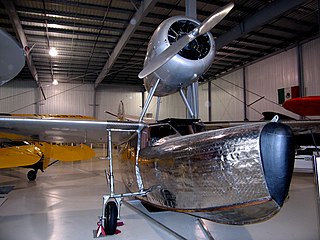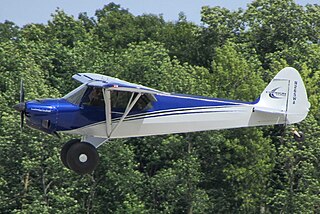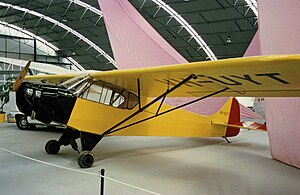
The Piper J-3 Cub is an American light aircraft that was built between 1938 and 1947 by Piper Aircraft. The aircraft has a simple, lightweight design which gives it good low-speed handling properties and short-field performance. The Cub is Piper Aircraft's most-produced model, with nearly 20,000 built in the United States. Its simplicity, affordability and popularity invokes comparisons to the Ford Model T automobile.

The Ace Baby Ace, a single-seat, single-engine, parasol wing, fixed-gear light airplane, was marketed as a homebuilt aircraft when its plans were first offered for sale in 1929 — one of the first homebuilt aircraft plans available in the United States. Plans are still available and Baby Aces are still being built. Orland Corben designed a series of aircraft for the Ace Aircraft Manufacturing Company, the Baby Ace, Junior Ace, and Super Ace. Corben's name was associated with the aircraft, and it is commonly known as the Corben Baby Ace.

The Piper PA-15 Vagabond and PA-17 Vagabond are both two-seat, high-wing, conventional gear light aircraft that were designed for personal use and for flight training and built by Piper Aircraft starting in 1948.

The Piper PA-18 Super Cub is a two-seat, single-engine monoplane. Introduced in 1949 by Piper Aircraft, it was developed from the PA-11 Cub Special, and traces its lineage back through the J-3 Cub to the Taylor E-2 Cub of the 1930s. In close to 40 years of production, over 10,000 were built. Super Cubs are commonly found in roles such as bush flying, banner towing and glider towing.

The Taylor Cub was originally designed by C. Gilbert Taylor as a small, light and simple utility aircraft, evolved from the Taylor Chummy. It is the forefather of the popular Piper J-3 Cub, and total production of the Cub series was 23,512 aircraft.

The Cessna 340 is a twin piston engine pressurized business aircraft that was manufactured by Cessna.

The Piper PA-11 Cub Special is a later-production variant of the J-3 Cub manufactured by Piper Aircraft.

The Bellanca Viking and Super Viking are a series of single-engine, four-seat, high performance, retractable gear aircraft manufactured in the USA during the 1960s and 1970s. The aircraft developed through modifications of classic designs by the aviation pioneer Giuseppe Bellanca. A total of 1,356 Vikings have been produced with most production between 1968 and 1975.

The Aeronca Model 7 Champion, commonly known as the "Champ", or "Airknocker", is a single-engine light airplane with a high wing, generally configured with fixed conventional landing gear and tandem seating for two occupants.
The Piper PA-6 Sky Sedan was a 1940s American four-seat light aircraft designed and built in prototype form by Piper Aircraft at its Lock Haven, Pennsylvania, factory.
The Fike Model D was a light aircraft built in the United States in the early 1950s. Designed by airline pilot William Fike, it was a conventional high-wing strut-braced monoplane with tailskid undercarriage and seating for one or two people in an enclosed cabin. In appearance, the aircraft strongly resembled a Piper Cub, with only the tail surfaces sourced from one. An unusual feature was that the flight controls were mounted to the ceiling of the cabin, rather than the floor. This facilitated the folding or removal of the seat or seats to enable the aircraft's use as a sleeping space when camping with it. Plans were marketed for homebuilding.
The Fike Model E was a light aircraft built in the United States in the early 1970s. Designed by airline pilot William Fike, it was a conventional high-wing cantilever monoplane with tailskid undercarriage and seating for one or two people in an enclosed cabin. The wing was an unusual geodesic wooden construction and was of far greater chord than typical for an aircraft of this type; indeed, one of the purposes of building the aircraft was to investigate the characteristics of a wing of such low aspect ratio (3.0). The empennage was taken from a Piper Cub, but was modified to reduce its span to make it suitable for towing on the road. Plans were made available for homebuilders in the mid 1970s.

The Fleetwings Sea Bird was an American-built amphibious aircraft of the 1930s.

The Maule M-4 is an American four-seat cabin monoplane designed by Belford Maule and built by the Maule Aircraft Company.

The Rose Parrakeet was a single-seat sporting biplane produced in small numbers in the United States during the 1930s. It was a conventional design with staggered single-bay wings of equal span braced by N-struts. The cockpit was open, and the fixed tailskid undercarriage had divided main units. An unusual feature was the use of a single strut in place of the usual flying wires.

The CubCrafters CC11-160 Carbon Cub SS is an ASTM certified light-sport aircraft based on the Piper J-3 Cub manufactured by Cub Crafters. It is modernized, with light-weight carbon fiber components and a 180 hp (130 kW) engine.

The Zlin Savage is a series of light sport aircraft similar in construction to the Piper Cub manufactured by the Zlin Aircraft Company of Zlín, Czech Republic.
The Henderson Little Bear is an American homebuilt aircraft that was designed and produced by Henderson Aero Specialities of Felton, Delaware, introduced in 1993. The aircraft is a replica of the Piper J-3 Cub. When it was available the aircraft was supplied as a kit or in the form of plans for amateur construction.

The Vega Model 2 Starliner was a prototype five-seat feeder airliner produced by the Vega Airplane Company, a subsidiary of Lockheed. It was designed to be powered by an unusual powerplant, consisting of two Menasco piston engines coupled together to drive a single propeller. A single example was built, flying in 1939, but no production followed.

The Taylor Chummy, originally the Arrowing Chummy is a light utility aircraft made by the Taylor Aircraft Company in the late 1920s. It was the fore-runner of the highly successful Piper Cub series.


















